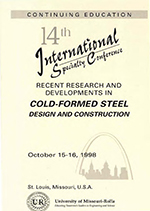Session Dates
15 Oct 1998
Abstract
A comprehensive system for the design of residential steel roof truss systems is presented. The research involved three distinct stages. In the first stage, components of the truss systems were tested in order to determine their member properties subjected to axial force and bending moments. Finite element simulations of these tests were carried out to further verify the, calculations obtained using the AISI-LRFD code guidelines. The AlSI-LRFD code based design curves were used for the actual design, while the laboratory experiments and the finite element results provided additional checks and verification of the AlSI values. The second stage of the research involved the development of an integrated design system that would automatically design a roof truss given minimal input and using the design curves as the performance constraints. A design optimization scheme based on the genetic algorithm was adopted to handle sizing, shape and topology variables in the design problem. A software system was developed to design the lowest cost truss given the input parameters. The third stage of the research involved full-scale testing of typical, residential steel roofs designed using the developed software system. Roof trusses were loaded to failure. The full scale testing procedure established the factor of safety while validating the analysis and design procedures. Evaluation of the test results indicates that the present design system provides enough reserve strength for the structure to perform as predicted.
Department(s)
Civil, Architectural and Environmental Engineering
Research Center/Lab(s)
Wei-Wen Yu Center for Cold-Formed Steel Structures
Meeting Name
14th International Specialty Conference on Cold-Formed Steel Structures
Publisher
University of Missouri--Rolla
Document Version
Final Version
Rights
© 1998 University of Missouri--Rolla, All rights reserved.
Document Type
Article - Conference proceedings
File Type
text
Language
English
Recommended Citation
Mobasher, B.; Chen, S-Y; Young, C.; and Rajan, S. D., "A Cost Based Approach to Design of Residential Steel Roof Systems" (1998). CCFSS Proceedings of International Specialty Conference on Cold-Formed Steel Structures (1971 - 2018). 1.
https://scholarsmine.mst.edu/isccss/14iccfsss/14iccfsss-session11/1
A Cost Based Approach to Design of Residential Steel Roof Systems
A comprehensive system for the design of residential steel roof truss systems is presented. The research involved three distinct stages. In the first stage, components of the truss systems were tested in order to determine their member properties subjected to axial force and bending moments. Finite element simulations of these tests were carried out to further verify the, calculations obtained using the AISI-LRFD code guidelines. The AlSI-LRFD code based design curves were used for the actual design, while the laboratory experiments and the finite element results provided additional checks and verification of the AlSI values. The second stage of the research involved the development of an integrated design system that would automatically design a roof truss given minimal input and using the design curves as the performance constraints. A design optimization scheme based on the genetic algorithm was adopted to handle sizing, shape and topology variables in the design problem. A software system was developed to design the lowest cost truss given the input parameters. The third stage of the research involved full-scale testing of typical, residential steel roofs designed using the developed software system. Roof trusses were loaded to failure. The full scale testing procedure established the factor of safety while validating the analysis and design procedures. Evaluation of the test results indicates that the present design system provides enough reserve strength for the structure to perform as predicted.



